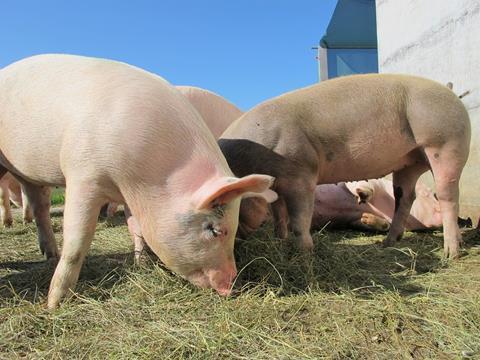Despite a significant reduction in household spending on pork and cured pig meat products, GB prime pig producer prices were running 3.5% above 2018 levels at the end of August, according to the latest market analysis by Quality Meat Scotland.

In addition to this, data from HMRC shows a 21% lift in exports during the second quarter of 2019 (Q2), with a strong surge in demand from China due to severe pork shortages.
“At the end of last month, the Standard Pig Price was trading at 153.3p/kg dwt. Once heavier carcase weights have been factored in, each carcase was worth around 4.5% more than a year earlier,” said Iain Macdonald, QMS Senior Economics Analyst.
“This rise has come despite consumption figures from Kantar Worldpanel signaling a significant reduction in household spending on pork and cured pigmeat products like bacon and deli meats. In addition, Defra slaughter statistics point to an increase in UK pigmeat production this year, rising around 2.5% on 2018 in the three months to July.
“For the market to firm in this context it has required favourable movements in imports and exports. Defra figures indicate that around 55% of the UK’s pigmeat supply came from overseas in 2018 while 28% of domestic production was exported, so global trade is clearly a significant factor in the prime pig market.”
On the import side, while volumes are reported to have risen strongly in the first quarter of the year, they then contracted heavily in the second quarter.
Exports have been growing strongly on the back of a surge in demand from China. Indeed, data from HMRC shows that the 21% lift in exports during the April to June period was almost entirely down to a near-doubling of sales to China/Hong Kong, with exports to other destinations rising only 1.5%.
“The reason for this strength in demand from China has been a severe pork shortage caused by African Swine Fever,” explained Mr Macdonald. “In the spring of 2019, the first signs of shortages pushed up China’s import requirements, raising global market prices. According to the Chinese Ministry of Agriculture, pork imports climbed by more than a quarter in the first half of 2019, with imports of beef, lamb, milk powder and seafood also growing strongly to make up the shortfall in protein supply.”
Latest data from China points to a year-on-year reduction in pig numbers by around a third, while wholesale pork prices surged by around a third in August alone, pushing them more than 80% above their February low point and nearly 70% above year earlier levels.
As a major supplier of pork to China already, with export approvals much easier to come by than in the beef and lamb processing sectors, a number of EU countries, including the UK, were well-placed to meet this demand. EU exports of pork to China/Hong Kong rose by nearly 70% year-on-year in Q2 2019. Sales of processed pigmeat, fats and offals also rose considerably, supporting carcase balance.
“As well as market access, UK and EU processors have also benefited indirectly from the ongoing trade war between China and the US, with higher tariffs on US pork giving EU and UK pigmeat a significant competitive advantage,” said Mr Macdonald.
“The latest round of tariff hikes on US pork happened at the beginning of September. For example, US companies, which had already been facing tariffs as high as 62% for frozen bone-in cuts of pork, are now facing a 72% tariff wall compared to a 12% tariff for EU and UK exporters of these products.
“Firm demand from China has boosted EU pig prices, which are around 20% higher than last year and have been trading above the UK average price since mid-April. Given the high level of imports to the UK from the EU, higher import prices will have boosted the competitiveness of home produced pigmeat on the UK market, providing further support to farmgate prices.”
This story was originally published on a previous version of the Meat Management website and so there may be some missing images and formatting issues.















